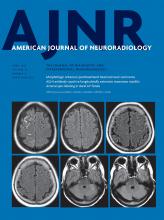Index by author
Barker, P.B.
- Adult BrainOpen Access7T Brain MRS in HIV Infection: Correlation with Cognitive Impairment and Performance on Neuropsychological TestsM. Mohamed, P.B. Barker, R.L. Skolasky and N. SacktorAmerican Journal of Neuroradiology April 2018, 39 (4) 704-712; DOI: https://doi.org/10.3174/ajnr.A5547
Becker, M.
- FELLOWS' JOURNAL CLUBHead and Neck ImagingYou have accessMRI with DWI for the Detection of Posttreatment Head and Neck Squamous Cell Carcinoma: Why Morphologic MRI Criteria MatterA. Ailianou, P. Mundada, T. De Perrot, M. Pusztaszieri, P.-A. Poletti and M. BeckerAmerican Journal of Neuroradiology April 2018, 39 (4) 748-755; DOI: https://doi.org/10.3174/ajnr.A5548
The authors analyzed 1.5T MRI examinations of 100 consecutive patients treated with radiation therapy with or without additional surgery for head and neck squamous cell carcinoma. MRI examinations included morphologic sequences and DWI. Histology and follow-up served as the standard of reference. Two readers, blinded to clinical/histologic/ follow-up data, evaluated images according to clearly defined criteria for the diagnosis of recurrent head and neck squamous cell carcinoma/second primary head and neck squamous cell carcinoma occurring after treatment, post-radiation therapy inflammatory edema, and late fibrosis. They conclude that adding precise morphologic MRI criteria to quantitative DWI enables reproducible and accurate detection of recurrent head and neck squamous cell carcinoma/second primary head and neck squamous cell carcinoma occurring after treatment.
Bednarek, D.R.
- NeurointerventionOpen AccessA Patient Dose-Reduction Technique for Neuroendovascular Image-Guided Interventions: Image-Quality Comparison StudyA. Sonig, S.V. Setlur Nagesh, V.S. Fennell, S. Gandhi, L. Rangel-Castilla, C.N. Ionita, K.V. Snyder, L.N. Hopkins, D.R. Bednarek, S. Rudin, A.H. Siddiqui and E.I. LevyAmerican Journal of Neuroradiology April 2018, 39 (4) 734-741; DOI: https://doi.org/10.3174/ajnr.A5552
Bergsland, N.
- Adult BrainYou have accessEvaluation of Leptomeningeal Contrast Enhancement Using Pre-and Postcontrast Subtraction 3D-FLAIR Imaging in Multiple SclerosisR. Zivadinov, D.P. Ramasamy, J. Hagemeier, C. Kolb, N. Bergsland, F. Schweser, M.G. Dwyer, B. Weinstock-Guttman and D. HojnackiAmerican Journal of Neuroradiology April 2018, 39 (4) 642-647; DOI: https://doi.org/10.3174/ajnr.A5541
Bernardeschi, D.
- Head and Neck ImagingYou have accessIntraoperative Conebeam CT for Assessment of Intracochlear Positioning of Electrode Arrays in Adult Recipients of Cochlear ImplantsH. Jia, R. Torres, Y. Nguyen, D. De Seta, E. Ferrary, H. Wu, O. Sterkers, D. Bernardeschi and I. MosnierAmerican Journal of Neuroradiology April 2018, 39 (4) 768-774; DOI: https://doi.org/10.3174/ajnr.A5567
Bharatha, A.
- FELLOWS' JOURNAL CLUBADULT BRAINYou have accessHARMless: Transient Cortical and Sulcal Hyperintensity on Gadolinium-Enhanced FLAIR after Elective Endovascular Coiling of Intracranial AneurysmsS. Suthiphosuwan, C.C.-T. Hsu and A. BharathaAmerican Journal of Neuroradiology April 2018, 39 (4) 720-726; DOI: https://doi.org/10.3174/ajnr.A5561
The authorsconducted a retrospective review of 58 patients with 62 MR imaging studies performed within 72 hours following endovascular treatment of intracranial aneurysms. Patient demographics, aneurysm location, and vascular territory distribution of cortical and sulcalhyperintensity on gadolinium-enhanced FLAIR were documented. Cortical and sulcalhyperintensity on gadolinium-enhanced FLAIR was found in 51.61% of post-endovascular treatment MR imaging studies, with complete resolution of findings in all patients on the available follow-up studies (27/27). Angiographic iodinated contrast medium injection and arterial anatomy matched the vascular distribution of cortical and sulcalhyperintensity on gadolinium-enhanced FLAIR. Thishyperintensity is a transient observation in the arterial territory exposed to iodinated contrast medium during endovascular treatment of intracranial aneurysms, and is significantly associated with procedural time and the frequency of angiographic runs, suggesting a potential technical influence on the breakdown of the BBB.
Bodanapally, U.K.
- Adult BrainYou have accessDual-Energy CT in Hemorrhagic Progression of Cerebral Contusion: Overestimation of Hematoma Volumes on Standard 120-kV Images and Rectification with Virtual High-Energy Monochromatic Images after Contrast-Enhanced Whole-Body ImagingU.K. Bodanapally, K. Shanmuganathan, G. Issa, D. Dreizin, G. Li, K. Sudini and T.R. FleiterAmerican Journal of Neuroradiology April 2018, 39 (4) 658-662; DOI: https://doi.org/10.3174/ajnr.A5558
Boto, J.
- Spine Imaging and Spine Image-Guided InterventionsYou have accessNormal Values of Magnetic Relaxation Parameters of Spine Components with the Synthetic MRI SequenceM. Drake-Pérez, B.M.A. Delattre, J. Boto, A. Fitsiori, K.-O. Lovblad, S. Boudabbous and M.I. VargasAmerican Journal of Neuroradiology April 2018, 39 (4) 788-795; DOI: https://doi.org/10.3174/ajnr.A5566
Boudabbous, S.
- Spine Imaging and Spine Image-Guided InterventionsYou have accessNormal Values of Magnetic Relaxation Parameters of Spine Components with the Synthetic MRI SequenceM. Drake-Pérez, B.M.A. Delattre, J. Boto, A. Fitsiori, K.-O. Lovblad, S. Boudabbous and M.I. VargasAmerican Journal of Neuroradiology April 2018, 39 (4) 788-795; DOI: https://doi.org/10.3174/ajnr.A5566
Bowen, J.D.
- EDITOR'S CHOICEAdult BrainOpen AccessIron-Insensitive Quantitative Assessment of Subcortical Gray Matter Demyelination in Multiple Sclerosis Using the Macromolecular Proton FractionV.L. Yarnykh, E.P. Krutenkova, G. Aitmagambetova, P. Repovic, A. Mayadev, P. Qian, L.K. Jung Henson, B. Gangadharan and J.D. BowenAmerican Journal of Neuroradiology April 2018, 39 (4) 618-625; DOI: https://doi.org/10.3174/ajnr.A5542
Fast macromolecular proton fraction mapping is a recent quantitative MR imaging method for myelin assessment. Macromolecular proton fraction and T2* maps were obtained from 12 healthy controls, 18 patients with relapsing-remitting MS, and 12 patients with secondary-progressive MS using 3T MR imaging. The macromolecular proton fraction in all subcortical structures and T2* in the globus pallidus, putamen, and caudate nucleus demonstrated a significant monotonic decrease from controls to patients with relapsing-remitting MS and from those with relapsing-remitting MS to patients with secondary-progressive MS. The macromolecular proton fraction in all subcortical structures significantly correlated with the Expanded Disability Status Scale and MS Functional Composite scores and provides an iron-insensitive measure of demyelination.








